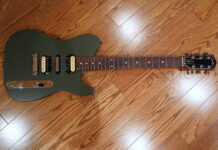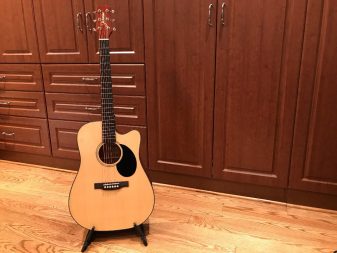 There are many acoustic guitars on the market. A lot of them follow the same tried and true principals, and it can sometimes seem that the models are indistinguishable from one another. A closer look can reveal subtle differences that greatly affect playability. The Jasmine JD36-CE is such an example. Let’s take a look to see how this particular instrument is different from the others.
There are many acoustic guitars on the market. A lot of them follow the same tried and true principals, and it can sometimes seem that the models are indistinguishable from one another. A closer look can reveal subtle differences that greatly affect playability. The Jasmine JD36-CE is such an example. Let’s take a look to see how this particular instrument is different from the others.
First of all, check out this short video I made featuring sound examples of the acoustic and plugged-in tones that the guitar offers. I’ve also documented my first impressions and how the particular specifications of this model affect the playability.
Features that enhance playability
Versatile design and good materials
The JD36-CE is based on the widespread Dreadnought shape. This full size body build produces a good amount of volume and bass frequencies for a full sound when strumming. It still has a delicate side and singing mids though, to offer a pleasant finger style platform. The body features a cutaway. This rounded space is removed from the body to offer an easier access to the upper register. While more traditional constructions omit this feature, more modern players that play higher chords and lead lines will appreciate the added comfort of playing in that area of the neck.
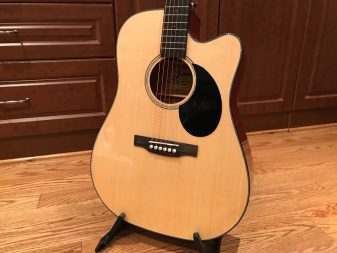
The guitar is built with quality materials. First of all, the top is made out of spruce, the most commonly used wood for acoustic guitar tops. The back and sides are crafted out of Sapele, which is reminiscent of Mahogany—a warm and rich wood used in acoustics and electrics alike. Similarly, the neck features Nato, another Mahogany-like material. The fingerboard is a nice piece of rosewood, a good addition to this already great package.
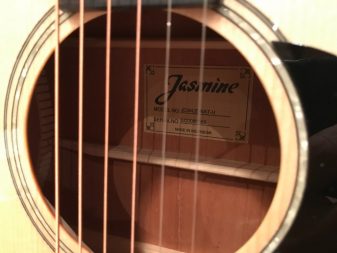 A very interesting thing to note is the shortened scale length of the JD36-CE. This scale represents the distance between the nut and the bridge. Traditionally this measures 25.5 (25.4 in some cases) inches. This particular guitar has a 24.75 length. This doesn’t mean that the guitar is for younger players though. It’s a full-size instrument that happens to have slightly narrower frets and slinkier, softer-feeling strings. If you’ve ever compared the fretboard of a Stratocaster to the one on a Les Paul, it’s the same exact feeling. This is perfect for beginners, people with smaller hands, and players interested in more modern playing that requires dextrous left hand techniques.
A very interesting thing to note is the shortened scale length of the JD36-CE. This scale represents the distance between the nut and the bridge. Traditionally this measures 25.5 (25.4 in some cases) inches. This particular guitar has a 24.75 length. This doesn’t mean that the guitar is for younger players though. It’s a full-size instrument that happens to have slightly narrower frets and slinkier, softer-feeling strings. If you’ve ever compared the fretboard of a Stratocaster to the one on a Les Paul, it’s the same exact feeling. This is perfect for beginners, people with smaller hands, and players interested in more modern playing that requires dextrous left hand techniques.
On-board electronics
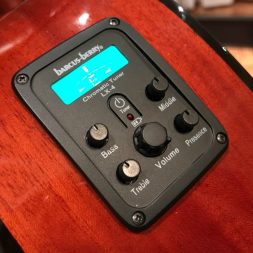 The “CE” in JD36-CE refers to the cutaway, but also to the mounted electronics. On this model, there is a B-Band designed M-450t under saddle piezo pickup. This system enables you to plug your instrument into a PA system for live performances and amplification, or an audio interface to record without setting up microphones. They provide a snappy and immediate type of sound that you probably heard countless times without knowing it in singer songwriter style performances, and even studio recordings.
The “CE” in JD36-CE refers to the cutaway, but also to the mounted electronics. On this model, there is a B-Band designed M-450t under saddle piezo pickup. This system enables you to plug your instrument into a PA system for live performances and amplification, or an audio interface to record without setting up microphones. They provide a snappy and immediate type of sound that you probably heard countless times without knowing it in singer songwriter style performances, and even studio recordings.
This particular system was new to me, but I was pleasantly surprised to see a three-band EQ (featuring bass, mid, and treble controls), as well as a presence knob. There is also a volume potentiometer to adjust your level to the desired amount.
An excellent addition to this unit is the screen and tuner. This means that you’ll always have a tuner on board of your guitar, no matter if it’s plugged in or not. It also mutes your signal when you use it, so your audience won’t hear the plucking of open strings and actual tuning through the PA system.
Easy on the fingers, without sacrificing tone
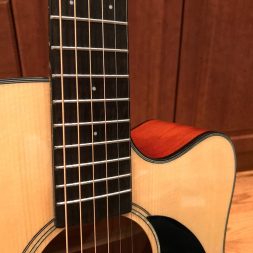 Thanks to the slightly shorter scale, the JD36-CE is very easy to play. The slightly narrower frets are always nearby and feel accessible—even in the lower register. This makes me think that this model will enable beginners to quickly develop their technique and somewhat reduce the struggle at the start. The strings also feel slightly looser, thanks to the shorter scale. The cutaway is also great for picking single notes in the higher register. This gives you a lot more options if you like to solo on your acoustic.
Thanks to the slightly shorter scale, the JD36-CE is very easy to play. The slightly narrower frets are always nearby and feel accessible—even in the lower register. This makes me think that this model will enable beginners to quickly develop their technique and somewhat reduce the struggle at the start. The strings also feel slightly looser, thanks to the shorter scale. The cutaway is also great for picking single notes in the higher register. This gives you a lot more options if you like to solo on your acoustic.
This slightly shrunken guitar doesn’t suffer tone-wise, though. If you’ve ever tried a 3/4 instrument or something smaller intended for children, you probably noticed a pretty big difference. It’s not the case here; the sound is pleasant and full-bodied.
The plugged-in tone is a typical piezo tone. It’s slightly zingy and crisp. I’ve always thought this was because the actual pickup is mounted underneath the bridge saddles. Strings always sound more trebly when playing closer to the bridge. You can mitigate this by using the onboard EQ, but the source of the signal will always be of that nature.
Great value for money
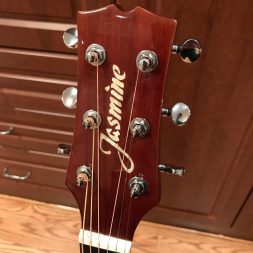 With its specifications and included electronics, it’s hard not to recommend the JD36-CE to many different players. First of all, for those just getting into the instrument, it’s a great place to start. It’s affordable, made out of quality materials, sounds good, and it even has onboard electronics (and a tuner). The pickup makes it an ideal choice to grow with, since you’ll be able to take it with you and plug it in for future performances. You won’t even need to spend money on an external tuner! Also, the shorter scale will make things a little bit more inviting to the newcomer. It can be a bit frustrating to get your hand used to the size of the guitar in the beginning, so every little advantage can help to get over this hurdle.
With its specifications and included electronics, it’s hard not to recommend the JD36-CE to many different players. First of all, for those just getting into the instrument, it’s a great place to start. It’s affordable, made out of quality materials, sounds good, and it even has onboard electronics (and a tuner). The pickup makes it an ideal choice to grow with, since you’ll be able to take it with you and plug it in for future performances. You won’t even need to spend money on an external tuner! Also, the shorter scale will make things a little bit more inviting to the newcomer. It can be a bit frustrating to get your hand used to the size of the guitar in the beginning, so every little advantage can help to get over this hurdle.
For current guitarists, this is an affordable and versatile model that you won’t be afraid to carry with you anywhere you go, as a main acoustic or backup. Again, the electronics greatly enhance the value of this particular product. The cutaway is also something you might benefit from if your current guitars don’t feature one. If you play mainly electric, this is a good choice that covers a lot of ground for your sparse acoustic needs. You might even fall in love with the shorter scale and never look back!
Check out the Jasmine JD36-CE on Best Buy’s website.

